Page of Wands meaning, messenger, creativity
Earth of Fire – message of inspiration.
elitarot2stikingly.com
Above all things, know thyself!
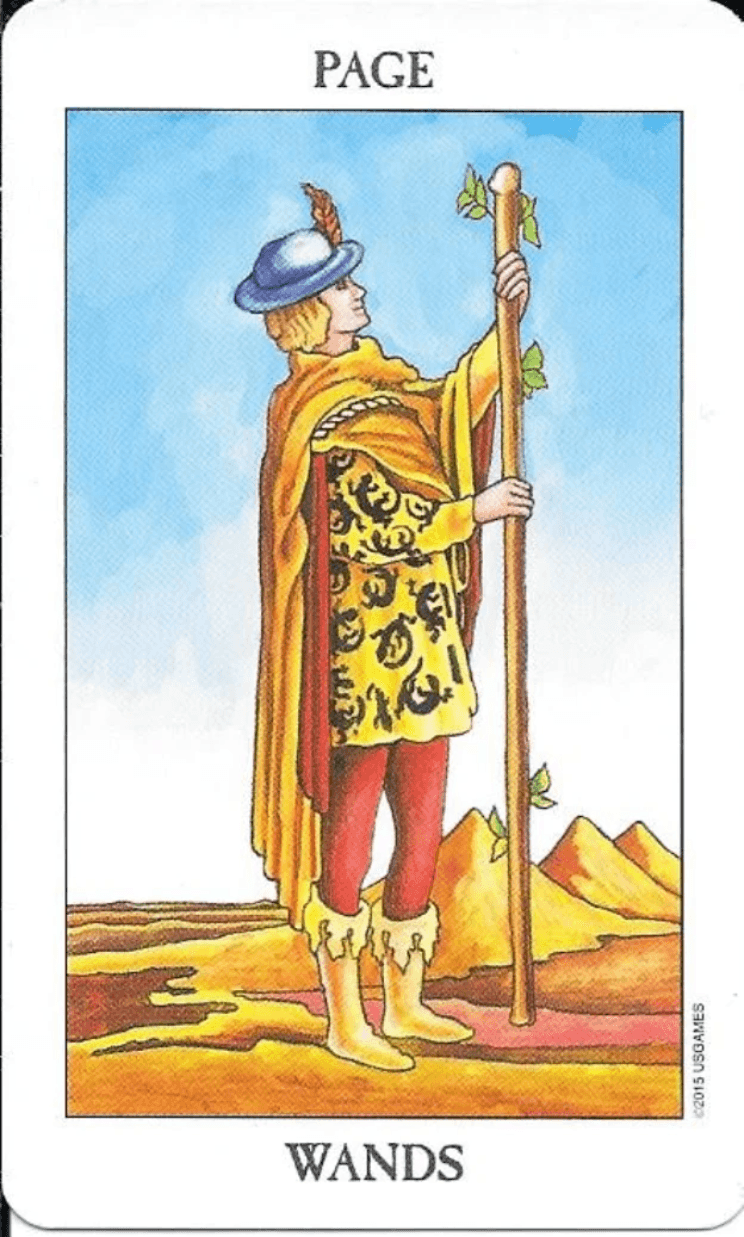
Radiant: Rider-Waite-Smith Tarot- Page of Wands
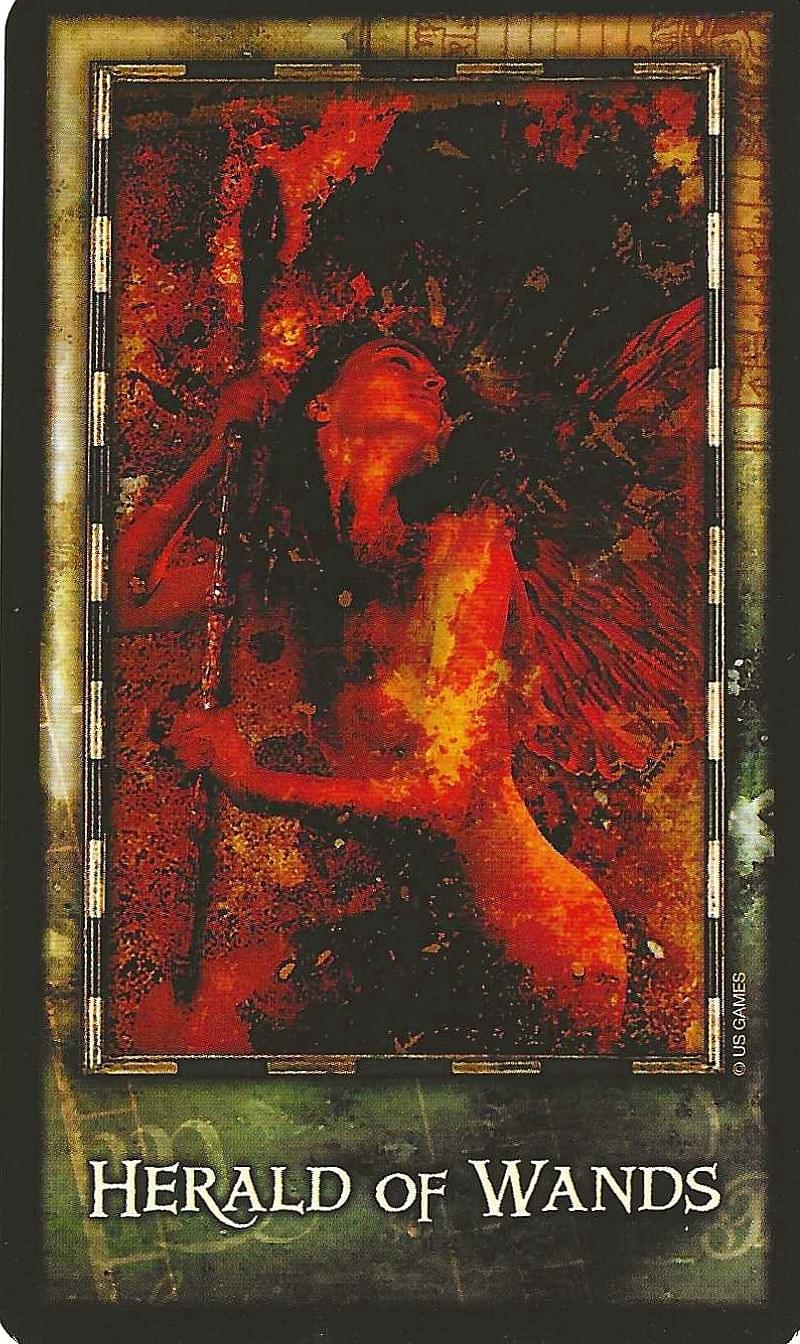
The Animal Totem Tarot - Page of Wands.

📜 1. Medieval Iconography and the Suppression of the Feminine
During the height of the Inquisition (13th–17th centuries), European art and symbolism were tightly policed by the Roman Catholic Church, which wielded near-total ideological authority. The Church’s doctrine leaned heavily on a literal reading of Genesis: Eve as the temptress, the root of sin, and the reason for humanity’s fall. This narrative served as the foundation for centuries of misogyny and was weaponized to keep women—and by extension the feminine principle—subordinate and excluded from positions of spiritual authority.
Iconographic censorship: Any symbol or image that elevated the feminine beyond the roles of Virgin Mary or sinner (Madonna or Magdalene) was often suppressed or destroyed.
Result in Tarot: The early Italian Trionfi and Marseille decks reflected this cultural context—Court cards were limited to Kings, Queens, Knights, and Pages. The “Page” archetype, while gender-neutral in concept, was typically depicted as male to reinforce patriarchal lineage and succession.
Thus, the absence of Princes and Princesses wasn’t accidental—it was part of a broader ecclesiastical campaign to erase the esoteric feminine from the Western symbolic psyche.
🌿 2. “To Work and Guard the Garden”: Genesis 2:15 Reconsidered
Our inclusion of the Hebrew original is key. The verb "לְעָבְדָהּ" (le’ovdah) derives from avad, meaning to serve, to till, to work for, but also to be enslaved by. And "לְשָׁמְרָהּ" (leshomrah) means to guard or keep watch over. Together, these imply Adam was placed in Eden as a servant-guardian, not as a sovereign ruler. The Church’s translations softened this nuance, replacing “serve” with “cultivate” or “work,” obscuring the implication that Adam was created to serve YHWH’s estate.
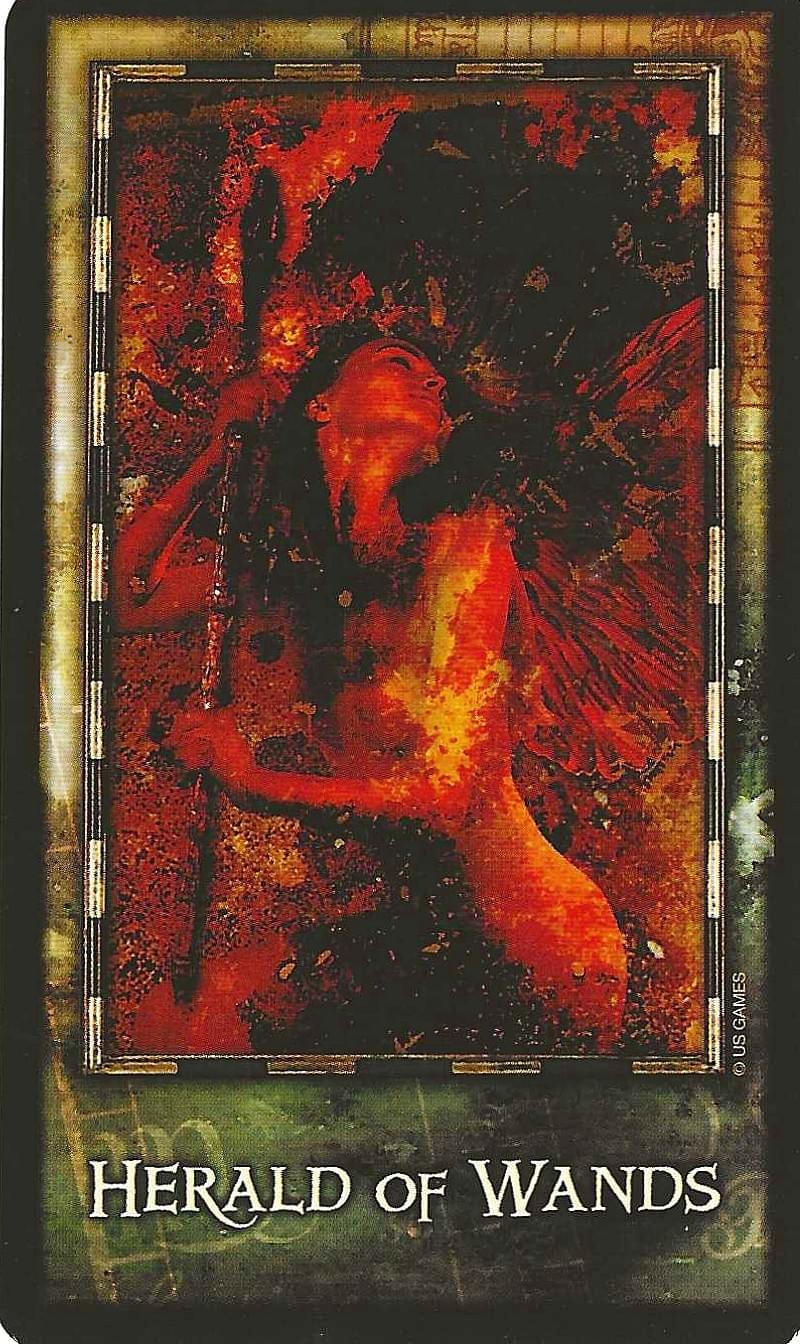
From a Hermetic perspective, this original Hebrew suggests that “the Fall” was not a punishment but a liberation. The expulsion from Eden freed humanity from servitude to the Demiurgic power (YHWH as Archon), allowing the Spark of Spirit to evolve beyond mere stewardship into conscious co-creation. Eve’s act, therefore, is not sin but initiation—an act of Gnosis that awakens the human soul from blind obedience.
🜂 3. Princes and Princesses: The Restored Archetypes of Force and Form
Crowley’s restoration of Princes and Princesses in the Thoth Tarot and Timothy Lantz's Herald of Wands, was a deliberate rectification of this imbalance. The fourfold Court is not just medieval hierarchy—it mirrors the fundamental structure of manifestation:
| Court Title | Elemental Role | Hermetic Principle | Sephirotic Function |
|---|---|---|---|
| Knight (King) | Yod – Father – Seed | Will to Force (Chokmah) | Dynamic impulse – Creative outpouring |
| Queen | Heh – Mother – Womb | Will to Form (Binah) | Formative matrix – Understanding |
| Prince | Vav – Son – Balance | Union of Force and Form (Tiphareth) | Solar Logos – Self-consciousness |
| Princess | Final Heh – Daughter – Earth | Manifestation (Malkuth) | Material embodiment – Receptacle |
By reintroducing these missing figures, the Thoth deck reestablishes the full Tetragrammaton (YHVH) cycle in human consciousness. The Princess, in particular, restores the dignity of the feminine as co-creator and ultimate manifestor, not passive recipient. She is the final crystallization of the Father’s Will and the Mother’s Understanding—the living temple of Spirit in matter.
🜁 4. Esoteric Implication: The Banishment as Initiation
The Garden myth, seen through the Hermetic lens, is not a tragedy but a symbol of humanity’s descent into density—a necessary alchemical stage. Eden represents the unconscious unity before individuation; the “Fall” is the separation of opposites—Spirit and Matter, Force and Form—without which evolution cannot occur.
Eve’s role is that of Sophia, the Divine Wisdom who awakens the Adamic shell to self-awareness. Her “temptation” is the spark of desire that moves humanity from passive servitude to active participation in the cosmic drama. In this light, the Church’s vilification of Eve and suppression of feminine archetypes is not merely misogyny—it is a strategic effort to obscure humanity’s path back to divine sovereignty.
🌞 5. Why Thoth and Wang Matter
By reintegrating the Prince and Princess, the Thoth and Jungian Tarot (Earlier blogs) decks restore the Qabalistic map to wholeness. They remind the initiate that:
Spirit requires Matter for self-knowledge.
Will without Form is chaos; Form without Will is inertia.
The Daughter (Princess) ultimately redeems the Father (Knight), fulfilling the cycle and returning Spirit to its Source enriched by experience.
This restoration is not just a revision of Tarot structure; it is a metaphysical correction of centuries of patriarchal distortion.

🌱 The True Garden Is Within: Eden as Inner Sanctuary
The Garden of Eden is not a lost paradise “out there” — it is the radiant state of consciousness within each of us before it was overgrown with weeds of dogma, fear, and false identity. Eden is the fertile inner soil (Adamah, from which Adam is formed), and humanity’s “banishment” was never geographical; it was psychological. We forgot that the Garden was never left — it was simply veiled by indoctrination and external authority.

In Hermetic terms, this is the exile from Da’ath — the “knowledge” that bridges inner and outer realities. When we accept the imposed story that we are “fallen” or “unworthy,” we close the gates of our own garden and forget that we are its gardener. Yet the serpent, the tree, and the fruit were never curses — they were keys to self-awareness. The so-called “fall” was the first step toward freedom, because consciousness that knows itself can choose its own becoming.
✨ “I AM” — The True Name of God Within
The sacred formula אהיה – Eheieh, “I Will Be”, is the Name of Kether — the Crown, the primal Will before form. When Moses asks for the Divine Name, the reply is Ehyeh Asher Ehyeh – “I Will Be That I Will Be” (Exodus 3:14). This is not a static identity but a verb of becoming. It is the eternal Creative Will announcing itself as infinite possibility.
When that primal “I Will Be” emanates into manifestation, it speaks through us as “I AM” — the conscious center of identity (Tiphareth). This is the Solar Self proclaiming its existence. Yet the content of that proclamation — what we say we are — is our sacred privilege and power. Every declaration (“I am strong,” “I am unworthy,” “I am love”) is a seed we plant in our inner Eden. Over time, those seeds become our lived reality — our fate (Moira).
Thus, to say “I AM” is to echo the Divine Word of creation. To declare what we are is to exercise the godlike power of shaping reality.
🌍 Malkuth: The Fulfillment of Divine Will
If you think we haven't " fallen" you are exactly right: we have not fallen from grace — we are Grace embodied. Malkuth, the 10th Sephirah, is not a realm of exile but the flowering of all that precedes it. The Will of Kether (Eheieh) flows down the Tree of Life, through Wisdom (Chokmah), Understanding (Binah), Beauty (Tiphareth), and manifests as Kingdom (Malkuth). And in that Kingdom, the Divine speaks as us — as “I AM Being.”
This is why the Princess is so vital in the Thoth Tarot: she is Malkuth personified — the Daughter who redeems the Father and raises the Kingdom back to the Crown. She is the living Eden, the embodied Will of the One. In her, the original “I Will Be” becomes “I AM.” And in us — every human soul — that same act is happening, every time we choose to declare ourselves anew.
🜂 The Return to Eden Is a Return to Self
The work of the Magus — and the deeper function of Tarot itself — is to remember Eden and reclaim our right to cultivate it. To stop living as if we are exiles in a hostile universe and start living as gardeners in a boundless inner paradise. Every act of conscious declaration, every “I AM” uttered with awareness, reopens the gates and tends the garden.
The tragedy of the medieval suppression of the feminine is that it severed us from the archetype of the Gardener-Goddess, the Sophia-Eve who awakens the Adamic shell to the creative Word. But the Thoth Tarot restores her, as Princess and Queen, as Shekinah and Sophia, as the embodied I AM Being.

🔥 1. The Hidden YHVH: Preserved in Image, Concealed in Language
Despite the oppressive dogma of the medieval Church, initiates of the Western Mysteries never forgot the sacred formula of יהוה – Yod-Heh-Vau-Heh — the divine cycle of creation. They knew:
Yod (י) – The Father, archetype of Will and seed, the fiery spark of creative impulse.
Heh (ה) – The Mother, archetype of Form and womb, the receptive matrix that shapes Will into potential.
Vau (ו) – The Son or Prince, the balancing Logos, mediating between archetype and manifestation.
Final Heh (ה) – The Daughter or Princess, the manifestation of the divine in matter, the Kingdom (Malkuth).
This fourfold pattern is the living pulse of creation itself — and it is the reason Crowley called the Court Cards “the key to all magical formulae.” But under the Inquisition, open depiction of the Daughter or Princess as a sovereign creative force would have been branded heresy. To avoid the stake, adepts encoded her presence in subtler forms.

🜂 2. The Page as Disguised Daughter
The “Page” or “Knave” of the early Latin and Marseille decks — later the Rider-Waite-Smith — is one such veil. While ostensibly male, these figures are almost always youthful, androgynous, or effeminate, hinting at the suppressed feminine principle. They are seeds of becoming — just as the Princess is the latent potential that rises to redeem and renew the Father.
This is why Crowley wrote that “the Princesses rule the heavens when they awaken the Eld of the All-Father” — meaning that the Daughter completes and revitalizes the cycle, raising Malkuth back to Kether. Even the medieval artists, constrained by orthodoxy, could not entirely erase her presence; they merely hid her in plain sight.
🌿 3. The Page of Wands: The Ignorant Magus Awakening
The Rider-Waite-Smith Page of Wands is a brilliant example of this subtext. A slender youth stands alone in the desert, gazing reverently at a budding staff. The pose is unmistakably phallic — as noted, his hand and gaze suggest the stirring of creative potency, an almost unconscious self-pleasuring gesture of awakening power.
But more profoundly:
He is “stroking” the wand of Will — the raw, unrefined fire of Yod — yet he does not yet know himself as the source of that power.
His proclamation is earnest but unformed — a first cry of “I AM” before the mind grasps its own creative authority.
The barren landscape emphasizes that this seed has yet to root in the fertile matrix of Heh — it awaits union with the Great Mother, the subconscious womb, to manifest as true creation.

Thus the Page of Wands is the Prince-in-becoming, the latent Princess rising from within the shell of youthful masculinity. He is the spark of self-knowledge seeking to remember its own Edenic nature — and his phallic staff is not mere sexuality, but the primordial lingam of consciousness awakening to its own generative power.
🜁 4. The Page’s Role in the Cycle of “I Will Be”
This moment — the Page’s dawning awareness — is where the sacred Name Eheieh (“I Will Be”) begins to echo as “I AM.” The Father’s Will (Yod) descends into the Daughter (final Heh), and from their union emerges the Prince (Vau), the conscious Self who proclaims the Word.
In this light, the Page of Wands is not merely a messenger — he is the first whisper of the Logos stirring within matter. He is the embryo of Magus, the Will-to-Create awakening from ignorance and preparing to name itself.
🌟 5. Androgyny as Resistance and Revelation
This is why the androgyny of the Pages is so crucial. It was both a mask for safety and a whisper of truth: the suppressed feminine principle cannot be extinguished, only hidden. Even when veiled in the guise of a youthful boy, the Daughter speaks through symbol and gesture. The wand’s budding leaves, the desert awaiting rain, the Page’s wonder at his own power — all these are metaphors of Shekinah, the Divine Presence in matter, awakening to Her sovereignty.

Tarot Personality birth wheel (Princess is a Page).

🔥 5. The Page of Wands: Embodiment of Untamed Fire
Clad in gold and red — the colors of elemental Fire — the Page of Wands is the very picture of the raw Yod-force in its most youthful and impulsive state. His tunic is adorned with salamanders, the legendary fire elementals of medieval alchemy, believed to dwell within flames and emerge unharmed from them. The presence of these creatures is not a quaint artistic flourish: it proclaims the Page’s essential nature as the spirit of fire seeking self-expression.
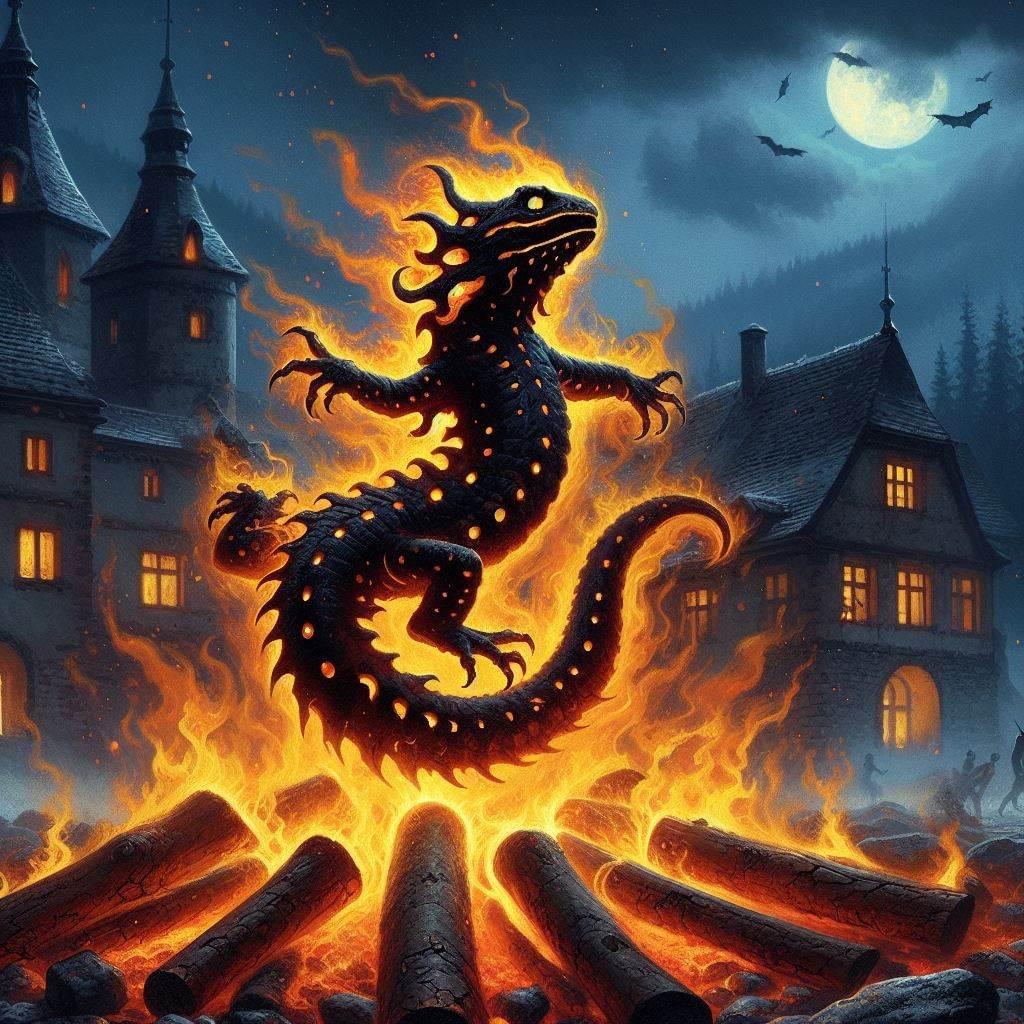
This is Fire as consciousness just awakening to itself — brilliant, exuberant, and volatile. Like a spark striking dry tinder, it flashes into passion and leaps toward action before reflection tempers it. It is the first stirring of creative Will that does not yet know itself as divine, but is nonetheless driven to proclaim and express.
🜂 The Ambivalent Nature of Fire
This duality — faithful friend and dangerous rival — is the hallmark of unrefined elemental fire. In the Page of Wands, we see both:
Devotion and enthusiasm: As a friend, lover, or messenger, this fiery youth is loyal and wholehearted. Once committed, their passion burns brightly, carrying messages and inspiration with almost evangelical zeal.
Impulsiveness and danger: But like fire itself, this energy is easily provoked. Quick to anger and swift to act, the Page can become a fierce rival if crossed, embodying the destructive side of elemental fire — consuming and overwhelming without restraint.
This polarity is not a flaw but a lesson: all elemental forces in their infancy are two-edged swords. The same flame that warms and illuminates can scorch and destroy. It is only through self-knowledge and direction — the maturation into Prince and then Knight — that fire’s brilliance is mastered and made creative rather than chaotic.
🜁 A Portrait of Passion in Its First Proclamation
In the Page’s youthful form, fire is pure amorousness and combustion — the ecstatic delight of being alive and burning with possibility. This is not the tempered solar radiance of Tiphareth, but the impulsive blaze of the first “I AM” bursting into manifestation. It is erotic, kinetic, and radiant, yet still naive. The Page does not yet direct fire; s/he is fire — raw, immediate, and unrefined.

Archeon Tarot-Herald of Wands
That is why this figure is both messenger and message: s/he is the tidings of Spirit itself, rushing ahead to declare the coming of the Will before it knows its own depth. Every proclamation, even if clumsy or self-congratulatory, is an act of the Divine saying, “I AM Becoming.”
🜃 The Hidden Daughter in Fiery Form
And beneath the youthful, almost androgynous exterior, the final Heh still whispers. Even clothed as a boy, this Page carries the seed of the Daughter — the creative matrix yearning to awaken. The salamanders on the tunic are not just spirits of flame but hints of the Shekinah in fiery descent, the feminine creative power beginning its ascent back to the Crown.
Thus, the Page of Wands is the Princess in disguise, the Kingdom stirring with the fire of Spirit, preparing to rise and complete the divine circuit of YHVH. This is why the Page’s journey is one of self-knowledge: from unconscious fire to conscious Will, from reactive spark to sovereign flame.

🜂 6. Waite’s Oath of Silence and the Cloaking of the Inner Doctrine
Arthur Edward Waite was not ignorant of the deep Hermetic currents beneath the Tarot — quite the contrary. As a high initiate of the Hermetic Order of the Golden Dawn, he knew the Qabalistic formulae, the Four Worlds, the Tetragrammaton, and the elemental structure of the Court Cards intimately. But as part of his oath-bound obligations, he veiled those teachings in symbolic language accessible to the outer court — what the Mysteries call the exoteric veil.
Thus, in the Rider–Waite–Smith Page of Wands, he does not overtly declare the figure as the final Heh or Daughter, nor does he openly proclaim the union of Will and Form. Instead, he presents the archetype in a form that would pass ecclesiastical scrutiny: a medieval page-boy bearing a flowering staff — a “safe” image of youthful service and vitality. Only the initiated eye recognizes this wand as a lingam of creative force and the sprouting leaves as signs of fertility and manifestation.
🜁 7. Immature Fire: Sexual Awakening as a Metaphor for Creative Becoming
Because he was bound to remain within the limits of orthodoxy, Waite encoded the inner meaning of Fire’s infancy in the most universally acceptable metaphor: sexual energy. Fire in its immature form is impulsive, fertile, erratic, and restless — just as human sexuality is in its early expressions. Hence the Page is often glossed in traditional interpretations as representing immature sexuality — an excitement that is spontaneous rather than sovereign, polymorphous rather than monogamous, exploratory rather than committed.
But this is more than a moral commentary: it is an allegory of the Will discovering itself. Before Fire becomes a conscious, directed force, it flickers wherever fuel presents itself. This “immaturity” is not a flaw — it is a necessary stage in the evolution from instinct to intent.
🜃 8. Pages as the Androgynous Matrix — The Hidden Princess
My point about the Pages’ effeminate qualities is central. In medieval decks like the Tarot de Marseille, the Knaves were consistently youthful and delicate, straddling the line between masculine and feminine. This was not accidental — it was the artist’s way of preserving the “final Heh” while avoiding the accusation of heresy.

The Page/Herald is not simply a “boy messenger.” S/He is the incipient Princess, the personality sheath in which the fiery spark of the Prince will awaken. Just as the Nephesh (vital soul) contains within it the potential for Ruach (intellectual soul), so too does the Page contain the seed of sovereignty that will one day mature into the Prince.
This dual nature — a youthful male appearance with feminine undertones — reflects the androgyne nature of the psyche itself. The Anima and Animus are not separate beings but complementary aspects within one consciousness. The brain, as many have so rightly noted, is both receptive (Heh, feminine) and projective (Yod, masculine) — and only their union produces true Logos (Vau).
Thus, the Page embodies the undivided soul before the mask of gender — the primal personality through which Spirit begins its work of self-expression. It is this Princess personality that receives the Will of the Father and the Understanding of the Mother and gives them form in the manifest world.
🜄 9. The Veiled Power Beneath the Innocence
Behind the Page’s innocent demeanor lies an explosive potential. The sprouting wand is not just an erotic symbol but a staff of divine authority — a miniature Tree of Life, crowned with leaves as Eden once was. It hints that even in its most unrefined state, Will-to-Create is inherently fecund, inherently divine.
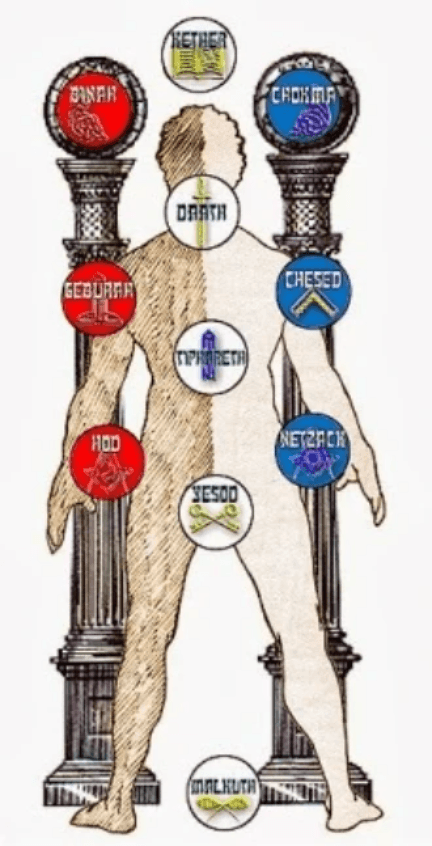
In time, this raw energy — so easily mistaken for mere “immature sexuality” — will evolve into the solar eros of Tiphareth, the creative radiance of the awakened Prince. But that journey begins here, in the Page’s naive self-stroking gesture — the first stirring of the Divine “I AM” within the field of personality.
This is why the Page of Wands is such an essential key to the Western Mysteries: it’s not simply “youthful enthusiasm” or “immature passion” — it’s the unconscious seed of Divine Will awakening within the human psyche, hidden behind the socially acceptable mask of a medieval page-boy.
Even constrained by oaths and inquisitors, Waite could not erase this truth — he could only veil it. And for those with eyes to see, the final Heh still speaks through that androgynous figure, sprouting the green shoots of the Inner Eden.

🜂 10. The Law of Inner Polarity: Outer Masks, Inner Complements
The ancient adepts knew — and Jung later articulated in psychological language — that every psyche is dual, containing both masculine (animus, soul) and feminine (anima, spirit) aspects. These are not mere gender qualities; they are universal creative polarities.
When the outer self (persona) is masculine — active, projective, willful — the inner self is feminine — receptive, intuitive, magnetic.
When the outer self is feminine — nurturing, formative, intuitive — the inner self is masculine — directive, penetrating, solar.
This principle is not social or biological but metaphysical: the outer always conceals and balances its inner opposite. It is the secret law of solve et coagula — the continual interplay of opposites through which consciousness evolves. And it is the hidden engine behind the Tetragrammaton itself: Father and Mother beget Son and Daughter — and Daughter returns to Father.
This “Law of Attraction,” as the old magi called it, is the very formula by which the Divine manifests through the human. Yet Waite, bound by the silence of his Order, could not risk revealing this alchemical truth to the uninitiated public.

🜁 11. Jung’s Anima and Animus: Modern Language for Ancient Mysteries
Carl Gustav Jung — who studied Hermetic and alchemical texts as deeply as psychology — gave modern language to this ancient principle. He called the inner feminine of a man the Anima (Spiritus, spirit) and the inner masculine of a woman the Animus (Soulus, soul). Both are archetypal figures of the psyche, shaping dreams, desires, and spiritual evolution.
This duality is not about gender but about energetic polarity. The anima is the vessel through which divine inspiration descends into the masculine mind; the animus is the spear through which the feminine soul asserts itself in the world. Together, they form the mystical marriage (hieros gamos) within the psyche — the same marriage depicted alchemically as Sun and Moon, Sulfur and Mercury, or King and Queen.
The Page of Wands — like the Thoth Princess of Wands — stands precisely at this liminal point: where the outer youthful fire is just beginning to awaken to its inner polarity. The Princess fully embodies this truth in the Thoth deck, but Waite’s Page only hints at it.

🜃 12. The Subtle Fire Symbols: Outer Veils of an Inner Mystery
Even though Waite refrained from teaching this principle explicitly, the symbolism of the card betrays its presence:
The red feather on the Page’s cap, shaped like a flame, is a direct glyph of Yod, the primal spark of divine Will — the fiery seed descending from the Crown. It crowns the head because this seed of spirit has entered consciousness, even if the Page does not yet know how to wield it.
The salamanders crawling across his tunic are the alchemical spirits of fire, guardians and personifications of the element itself. Their looping, circular shapes (often chasing their tails in older depictions) represent the cyclic nature of fire and transformation — the eternal dance of opposites within the psyche.
The gold and red of his garments reinforce his fiery nature and hint at the alchemical marriage — gold for the Sun (masculine, animus) and red for the blood and womb (feminine, anima).
Each of these is an esoteric breadcrumb leading the initiated mind back to the deeper teaching Waite could not state outright: that the fiery Will must unite with its inner complement before it can become sovereign creative power.
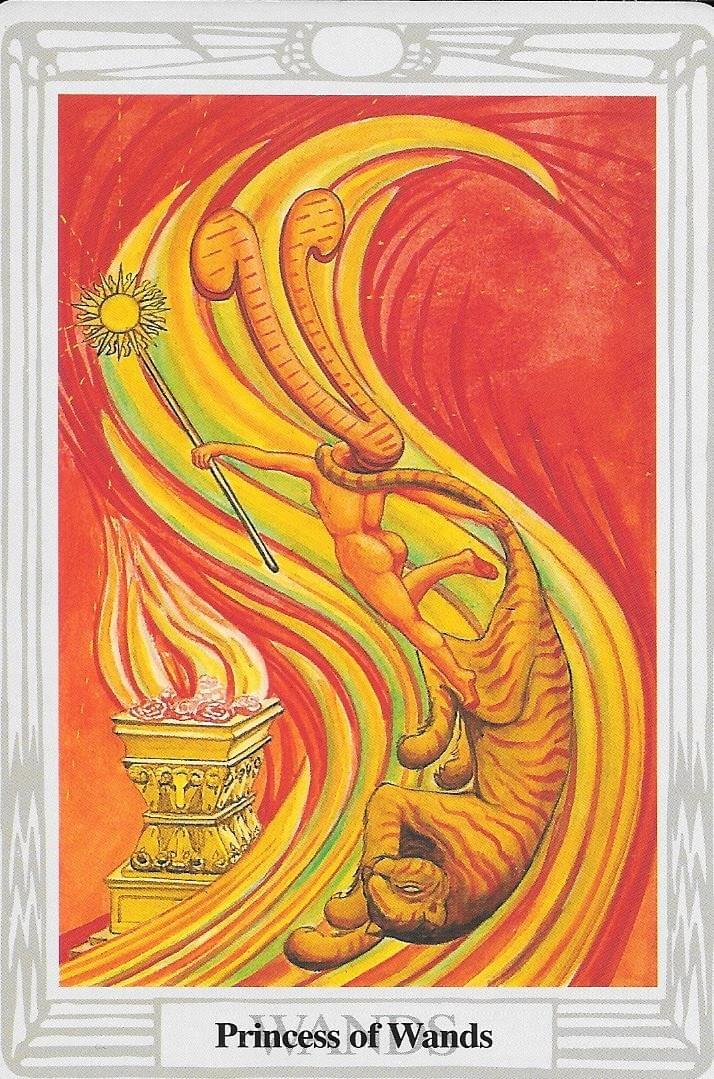
🜄 13. Page vs. Princess: The Outer and Inner Face of the Same Force
Thus, the Rider–Waite–Smith Page of Wands is the outer mask of a truth the Thoth Princess of Wands reveals more boldly. Both embody the fiery seed of new creation, but where the Princess stands unveiled as Malkuth’s flame rising toward Kether, the Page conceals that same force beneath the medieval disguise of a “messenger boy.”
Yet both archetypes teach the same initiatory lesson:
🔥 Fire must first awaken within personality before it can become Will.
🔥 Spirit and soul must unite within the psyche before consciousness can proclaim “I AM.”
🔥 Outer and inner selves must mirror one another before the Magus can direct the flame.
This, ultimately, is the inner “magic” that Waite did not (and perhaps could not) divulge — but which Crowley and Harris declared openly in the Thoth deck. The Page of Wands is the first spark of that alchemical fire, flickering with promise, yearning toward its own self-knowledge. He is not yet the Prince, but he is already more than he appears — the veiled Princess, the anima stirring within the animus, the first cry of Spirit clothed in the garments of the soul.

Archeon Tarot- Herald of Wands
🜂 14. Archeon Tarot — Herald/Page of Wands: The Unveiled Passion of the Herald
In the Archeon Tarot, the Page of Wands is transformed into a naked, angelic feminine figure, unabashedly embracing a flaming wand. This shift is significant: it pulls the archetype out from behind the masculine mask imposed by medieval convention and returns it to its true essence — the Daughter of Fire.
Here, the “Page” is no longer a veiled reference to the final Heh but a visible embodiment of it. Her nakedness speaks to vulnerability and authenticity, but also to truth unveiled: Spirit manifest without the masks of persona. She is Shekinah ignited — the receptive matrix that now burns with active Will.

The flaming wand she clasps is not just a symbol of passion; it is the lingam of divine consciousness — the raw Fire of Spirit she now embraces knowingly, rather than unconsciously stroking as in the RWS version. Where Waite’s Page wonders at the spark, the Archeon’s Herald claims it. Her passion is not hidden; it is proclaimed.
🜁 15. The Herald’s Message: Immature Feminine Fire
This portrayal captures the essence of the Herald of Wands — an archetype that announces not the seasoned authority of a Queen or the balanced command of a Prince, but the first joyful burst of feminine Fire. It is the fire of discovery, of pleasure in one’s own creative potency, of unashamed desire to be and become.
Thus, the upright meanings arise naturally:
🔥 Good news – the joyful announcement that something new and vital is stirring.
🌞 Pleasure and satisfaction – the delight in awakening creative energy and sensual passion.
⚡ Optimism and vigor – the rush of fresh enthusiasm that accompanies the birth of new force.
❤️ Excitement – the thrill of possibility, the first flutterings of desire before it matures into focused will.
All of these reflect the same core truth: this is immature feminine fire, the Anima igniting, spontaneous and exploratory, raw and radiant.
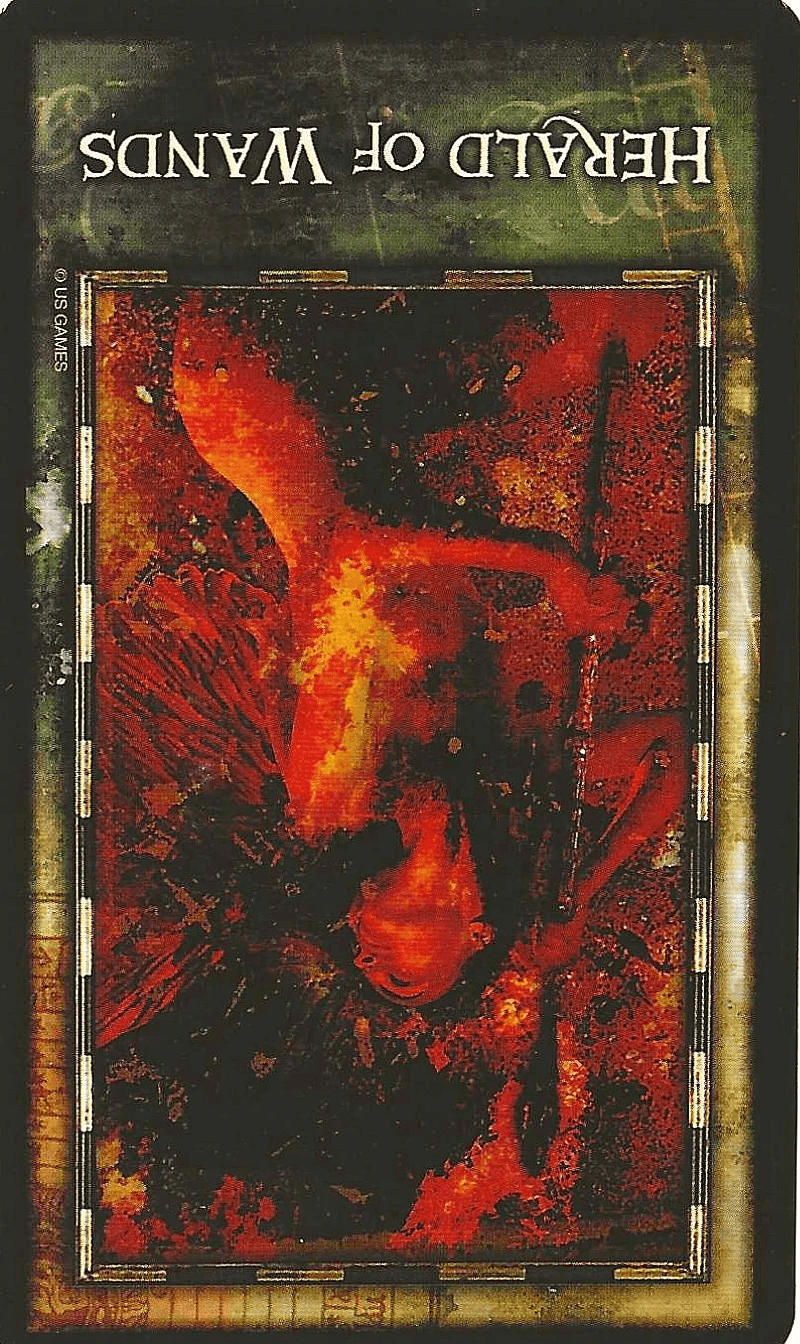
🜃 16. Reversed: The Shadow of Unrefined Fire
When reversed, the Herald reveals the shadow side of this archetype — the same way uncontrolled fire can scorch as well as warm:
⚠️ Ill news – premature declarations that fizzle or disappoint.
💔 Broken heart and displeasure – the volatility of immature passion, quick to ignite but just as quick to burn out.
😟 Worry and chagrin – the insecurity that arises when enthusiasm outpaces understanding.
This is the warning inherent in all Page cards: the force is real, but without grounding or maturation, it remains unstable. The fire that inspires can also consume.
🜄 17. The Princess Revealed: The Return of the Final Heh
What makes the Archeon depiction so valuable is that it restores the Princess aspect that medieval Tarot obscured. By presenting the Page as a naked feminine angel, it directly evokes the Princess of Wands of the Thoth Tarot — the Daughter of Fire, who holds the flaming wand aloft as a torch of divine identity.
Here, the “immature sexuality” is not merely carnal; it is the soul’s first sensual awareness of itself as a creative force. It is the stirring of Shekinah within matter, the moment when Spirit awakens to its own eros and begins to shape destiny.
This is the heart of the Page archetype in its truest, unmasked form: not a boyish messenger, but the Herald of Becoming — the first proclamation of the I AM rising from the depths of matter.

✨ Summary:

Tarot core personality birth chart (Princess of Wands is Page of Wands)
The Page/Princess/Herald of Wands is always acting on impulse s/he can be very witty and possesses an extraordinary imagination, often to the delight of those around him/her. However, s/he can be subject to great swings of mood; one minute s/he is the soul of decorum and the next s/he is exceptionally vulgar.
When alone, s/he often feels depressed. However, s/he is bursting with new ideas, and passionately seeking new things to do, to study and learn, although s/he doesn't have the experienced maturity necessary to follow through with fleeting passions.
[Have questions about Tarot, Qabalah and/or Magick, log onto Eli's Thoth Tarot Guide to get fast and concise information.]
When the Page of Wands is thrown in a divination it implies:
- A person whose beauty is created by their own vigorous energy.
- S/he represents immature sexuality and therefore, can be both seductive and permissive.
- This one's passion is so great that one is dazzled by a chemical reaction that enforces the impression of beauty on the beholder.
- Being a type of "spontaneous combustion", in anger or love s/he is violent. sudden, and implacable.
- S/he can often be irrational, when displaying her enthusiasm, fiery ambition, and aspiring nature.
- Such a Princess, never forgets an injury-----and the only patience she shows, is when lying in ambush to revenge a perceived wrong.
- S/he is often self-absorbed to the extent that she is entirely reckless in achieving gratification and is notably insatiable.
- However, as is all Power-----it is as destructive as it is constructive, so caution and encouragement compete in this one.
- Passion is the "big bang" of all Creation. But like all fires, one must know how to work with it, never against it, to properly achieve the necessary transformations of their Great Work.
If ill-defined and/or Reversed:
- The Page of Wands persona would be the defects of such passion.
- S/he would be superficial and theatrical, shallow and false while never expecting that s/he is anything of the sort.
- S/he becomes predominately a "spasm of mood" and s/he is cruel, unreliable, faithless and domineering.
Thank you for your interest, comments and supportive donations. May you live long and prosper.
Experience Tarot Readings with a Magus of the Thoth Tarot
Most people think Tarot is about fortune-telling, party tricks, or vague “mystical” predictions you’ve seen in Hollywood films. But the Tarot of Thoth—when read by a trained Magus—is something far more profound.
As a Western Hermetic Magus and Master of the Thoth Tarot, I offer one-on-one online readings that go beyond surface-level card meanings. Each session is a direct resonance between myself and the querent—spirit to spirit, mind to mind, body to body.
This is not about guessing your future. It is about awakening clarity, unveiling hidden forces, and aligning you with your own Solar Self. The Thoth Tarot is a Book of Universal Archetypes, encoded with Qabalistic, astrological, and alchemical wisdom. A reading with me brings these forces alive in your life in real time.
How My Readings Differ
Beyond the Mundane: I don’t just “interpret cards.” I read the dynamic flow of your Spirit–Mind–Body alignment through the Tarot’s Qabalistic architecture.
Direct Resonance: My one-on-one sessions are not mechanical. I attune to your presence and read both the seen and unseen currents shaping your life.
Hermetic Depth: As a Magus, I integrate the Tarot with the Tree of Life, planetary forces, and the Divine Archetypes that govern transformation. This opens insights that ordinary readings simply cannot access.
Empowerment, not Dependency: My goal is not to trap you in predictions, but to empower you with vision—so you can consciously co-create your path.
Why Choose a Magus Reading?
Because a true Magus does not read for you—he reads with you. Together, we explore your unique resonance with the living archetypes of the Tarot, peeling away the illusions of false ego and awakening your authentic Self.
✨ Book your private online reading today.
Special sliding-scale pricing is available so no seeker is turned away.
Discover the Tarot not as superstition, but as a sacred key to self-sovereignty, clarity, and transformation.
May you live long and prosper.
3 Western Hermetic Tarot and Magick websites helping people become more magic and less tragic since 2010.
Traditional Tarot Card Comparisons blog and tarot store.
Home page, Tarot store, Master Tarot Classes, and nontraditional Tarot Card Comparisons.
Western Hermetic Magick ritual and invocation website and blog.

